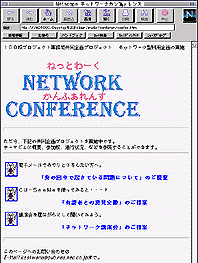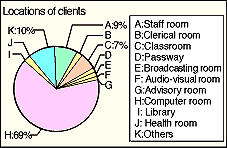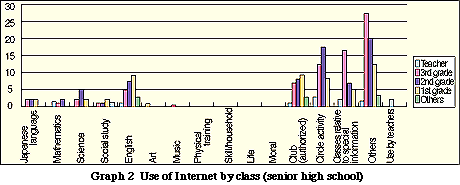
9th March 1996
Environment Education Using Internet
Activities for Acidic Rain Survey Project and
Supporting System
ATTACHED FUKUYAMA JUNIOR AND
SENIOR HIGH SCHOOL, HIROSHIMA UNIVERSITY
Takeshi Nagasawa
"A Tree" and "New Year's Day in Japan
SHINNO Elementary School, Minato-ku, Tokyo
Hitoshi Saito
Network Conference Type for
Developing Advanced Education System
Theme 1 of Joint Usage Plan: Events Arising in Daily Life
Akahori lab., Tokyo Institute of Technology
Yoshiki Suzuki
Report on Joint Usage Plan "Local Information Exchange"
Active Local Information Exchange and World Peace
Tezukayama Gakuin Izumigaoka High School
Yoichi Tsuji
Internet Usage Status Questionnaire
Overall Trends based on Questionnaire Results
Osaka University, Faculty of Human Sciences
Yuhei Yamauchi
100-School Networking Project Result Reporting Conference
No. 3 Sub-Committee
Network Conference Type for Developing Advanced Education System
Theme 1 of Joint Usage Plan: Events Arising in Daily Life
Akahori lab., Tokyo Institute of Technology
Yoshiki Suzuki
Objectives of the network conference "Events Arising in Daily Life" include to deepen interchange with other schools through opinion exchange on certain theme, to grow the ability to grasp a subject from versatile angles through knowing opinions at various standpoints and to upbring the ability to arrange and express one's own opinion against those of others. On the stand point of the information literacy, upbringing of the ability to arrange many information and to create the information easy-to-understand for receivers using the features of the mail and home page. Survey was carried out to evaluate changes through self-evaluation by students and observation by teachers using the questionnaire containing questions at the first and succeeding opinion exchange stages and at the end of the information exchange.
The outline is introduced in the order of the student survey results (41 students) and survey on teachers' evaluation.
Q:Information send: Do you feel uneasy to sent the information accurately?
Yes (12%), Slightly yes (32%)
Q: Information receive: Do you think you caught information as you wanted?��BR>
Yes (15%), Yes to some degree (53%)
Q: Are you satisfied that you received opinions of others?
Satisfied (31%), Satisfied to some degree (34%)
Questions on the 2nd opinion exchange and after (two answers or more accepted)
Q: Where did you find difficulty?
To accurately transfer own opinion (20 students), Remote friends cannot be seen (19 students), Time gap in opinion exchange (18 students), To correctly understand opinions of others (13 students), To conduct opinion exchange along the theme (12 students)
Q: On what points did you pay attention?
To express my opinion after arrangement (24 students),
Etiquette including wording to receivers (23 students),
Respect to other opinions (20 students)
Note: Ms. Kiyoko Yamaguchi, teacher of Nagoya City Seiryo Commercial Senior High School pointed out that students can speak, but have difficulties in writing their opinion, in the questionnaire.
Questions at the end of information exchange
Q: Do you think that you gained the ability of expression?
Yes to some degree (37%), Cannot be said which (39%)
Q: Is opinion exchange useful to learn netiquette?
Yes to some degree (41%), Cannot be said which (24%)
Several opinions of teachers after execution (answers by sentences) are introduced.
Mr. Kazuhiko Matsuda, teacher of Shiga Prefectural Nagara Elementary School, participated this project under a sever environment where he made students to input mails using only 3 computers available at the school, sent and received mails at his home and delivered received mails to the school. Matsuda teacher told on the questionnaire after execution, "since it was my first experience, there were many points that I could have handle better. (Omitted) Better evaluation may be done if time was secured for writing mails at the Japanese language write class. Other points are more efficient use of intermissions and I had not sufficient mental margin as there were many things to be done. If there will be a similar project in the future, please let me know and we will make more active mail exchange."
We received opinions of "We had opportunities of participation to Internet by Japanese language teachers" (Shinonoi Junior High School in Nagano Prefecture) and "We considered the joint project as the mean for gaining popularity of the information education at our school" (Taisha Junior High School in Shimane Prefecture) from schools of which students did not participated to the joint
project. As the above examples tell, the necessity of "creation of network among teachers" will be highlighted and, at the same time, the way to solve the most important point in educational use of the network be asked.
Next, while the number of information send and receive is somewhat low for teachers, students feel satisfaction higher than we expected. This correlates to how "events occurring during daily life" is interpreted and, further, it seemed that it is largely
 affected by the fact that students are satisfied by participating to the project even if each student did not act as sender of the information. For students, receiving opinions of others has an important significance.
affected by the fact that students are satisfied by participating to the project even if each student did not act as sender of the information. For students, receiving opinions of others has an important significance.
How teachers are involved is very important for "changes" of students. For example, the teacher of Nagara Elementary School made two copies, one to gave to the respective student and the other to be shown on the board. According to the teacher, "Students were delighted to receive responses from unknown students. When response was not return, they were looking for it." It is proven that the method is effective to make students to be "excited" with the activity. Further, it is extremely important to instruct students to write "encouraging and sharing impression of others" responses. The information exchange thereafter shown "drastic change" of correctly understanding opinion of others and then express their own opinions.
What is important for a network is not the hardware, but "friendly hear" to think about friends and the full of "passion" of teachers that supports students' activities. This "sincerity" is the first step towards establishment of reliable relationships.
100-School Networking Project Result Reporting Conference
No. 3 Sub-Committee
Report on Joint Usage Plan "Local Information Exchange"
Active Local Information Exchange and World Peace
Tezukayama Gakuin Izumigaoka High School
Yoichi Tsuji
Outline of this project was determined in the middle of November 1995, applicants were gathered and participants determined in December, and the actual operation began in the last January. The plan calls information exchange on top 5 '95 news, dream on the new year day and images on other regions was conducted as well as survey through questionnaire and analysis of the outcome. In March, a large theme of "World peace through use of Internet" is discussed and, at the final stage, a face-to-face conference is held at Osaka on March 9 for opinion exchange while deepening friendships.
Top 5 '95 News
Although the planner intended to local news, there were many schools who selected in-school news such as results of circle activities and congratulations/condoerances of teachers, like Osaka Shinai Girls High School and other schools. Many schools adopted the nuclear test as the world news. While students of Tezukayama High School discussed French nuclear test, Shjonawate Kita Senior High School included that by China. Difference in consciousness can be seen in these examples.
Dream on New Year Day
There were versatile dreams such as being chase������&Patrol car and to be a talent. While many dreams of Shjonawate Kita High School were related to circle and sport activities, Tezukayama school reported many talent and star related dreams. Since judgment by dream is difficult, it was merely enjoyed as a game. On the other hand, pictures of dreams created by students using the Picture software were presented on the home page, which was a useful method to acceleration of students' concern on the computer and has a possibility of comparing pictures among schools not only in Japan, but also in the world to checking difference by region and county.
Dream to the Future
While the nursery is ranked to the top at the Misato High School in Okinawa, students of Tezukayama pointed many occupations relating to English. The difference occurs since most students of Misato High School plan to find employments after graduation, they are conscious on occupations, while most students of Tezukayama take the international course and they consider employment after completing college. This point was analyzed by students and discussed on the home page.
Japan-South Korea Relationships
Students gave beam light to the Japan-South Korea relationships among image survey results to overseas countries. We had communications with two schools in South Korea and students of Tezukayama who visit there by the school excursion deepened their understanding on South Korea. Comparing with answers by students of Osaka Shinai Girl High School, response by Tezukayama students was, therefore, more negative against a question of "are the Japan-South Korea relationships friendly?" The result could be more severe if the analysis was made only for girl students of the International Course of Tezukayama since male students were included in the survey, whose school excursion was planned to Okinawa. Analyses by students are presented on the home page.
While the South Korea high schools who were not under the Internet environment used the facsimile for communications, their results were close to that of Tezukayama. As for the items concerning to overseas countries, Tezukayama listed versatile items while the number of items is limited to one for each country in South Korea. If the questionnaire was correctly prepared, it may show that students in South Korea is rather one sided for understanding in the Japan-South Korea relationships and other countries.
World Peace
No clear activities have been started on this theme, except introduction of the information on Hawaii Peace Center was p��������
Other activities and problem areas
Although information exchange has been carried out by producing mail groups composed of teachers of 11 member schools and students of 3 member schools, teachers not in charge of English had difficulties since English was frequently used as the Hawaii was included and restriction of facsimile communications existed for interchange with South Korea schools. Since no home pages are available for the 2 schools in Hawaii and Osaka Shinai although they are under the Internet environment, it could not help but the method to collect questionnaire and other information by Tezukayama must be taken.
As the Punahou jurnalism teacher wrote in a mail that considerable time was needed to understand the overall image of the project because of the limited time available before launch of the project, there were many teachers of other member schools who could first understand the objective of the project by reading the Tezukayama's home page being prepared slowly to the level suffice to understand. If possible, full-scale information exchange should be achieved in the second step, using the first step as the basis.
Educational effects to students
During exchange of electronic mails containing topics and their analyses, students learnt various application software and HTML and deepened understanding on the Internet. There are many participation methods such as a part of classes like at Doshisha International, Shijonawate Kita and Takatori and participation by voluntary students like at Misato and Tezukayama high schools. Students of Tezukayama who played the leading roles of the project learnt many things during the activities, we believe that students of member schools will learn more through study using the Internet.
100-School Networking Project Result Reporting Conference
No. 3 Sub-Committee
Internet Usage Status Questionnaire
Overall Trends based on Questionnaire Results
Osaka University, Faculty of Human Sciences
Yuhei Yamauchi
1. Introduction
The 100 school project secretariat conducted survey on status of Internet utilization in November 1995. Our laboratory (Education System Engineering Committee) cooperated in preparation and analyses of the questionnaire.
Because of the limited space available, only overall trends of the elementary, junior high and senior high schools are reported here by extracting important topics.
Detailed results are planned to be made open to the public using the server at the Education Software Development & Usage Promotion Center and that of Osaka University Human Engineering Dept. (http://www.hus.osaka-u.ac.jp/esthome/est_100snp.htmll).
 2. Internet Environment
2. Internet Environment
Client:
About 70% of clients that can be connected to the Internet are located in the computer room. There are schools who claimed that full utilization was difficult since the number of clients is 5 or less for 60% schools.
Management System and Training
Only 7% of system managers are specialized while 78% are concurrently serving as system managers in addition to their original functions. Operations are carried out without system manager at 7% of schools. However, 78% schools are trying to cover the situation by using the operation organizations such as the information education committee. No training is executed at 78% schools and only below 1% of schools were trained by public agencies such as the Education Center.
Problem Areas in Introduction and Active Utilization
Against the question asking difficulties encountered during installation of active utilization, many answered that terminologies used in the Internet are difficult (example: FTP, TCP/IP, IRC, etc.). (70 among 107 schools)
Problems are followed in the order of difficulties in operation computer and other equipment including software (52 schools), difficulties in understanding the obtained information because of English (or other languages) (51 schools), locations of desired information are unknown or cannot be searched (49 schools), and lack of teachers' passion in general terms (45 schools).
On the contrary, less educational difficulties were reported, including partner schools for interchange cannot be found (14 schools) and idea for active use of Internet cannot be found (2 schools). It is considered that operation at each school has not reached to the level encountering educational difficulties rather then there were no difficulties.
3. Use of Electronic Mail and WWW
The ratios where an electronic mail address is allocated to each individual are 51% for teachers and 23% for students. The preferable ratio is 94% for teachers while it is only 44% for students, against a question asking if the electronic mail can freely be used at any time.
There are 87 schools who have already opened the home page and creation is mainly controlled by teachers in charge of home page. Of the 107 school, only a part of teachers of 81 schools can handle the HTML. Among 87 schools who opened the home page, 38 schools are using WordtoWeb or other HTML creation auxiliary tools.
Introduction of the school history and the region is ranked the
 top in terms of contents of the home page, counting 80.5%
schools, followed by indication of education objective of each school (60%), linkage to other pages (59%), and introduction of the region (56%). About half of member schools (52%) demonstrates introduction of classes and students.
top in terms of contents of the home page, counting 80.5%
schools, followed by indication of education objective of each school (60%), linkage to other pages (59%), and introduction of the region (56%). About half of member schools (52%) demonstrates introduction of classes and students.
4. Use of Internet at Classes and Outside Classes
Graph 2 shows in which classes the Internet is used. It can be seen from the graph that the Internet is not often used in standard classes, but more for circle activities and time specially allocated for the purpose. The same trends can be seen to junior high and elementary schools. It is considered that these occur as more time is shared for acquiring knowledge on how to operate the Internet and time for international interchange does not fit to the existing classes.
The mostly used application for classes is the WWW, reaching 40%, followed by the E-mail of 34%. It is understood that these two are the main applications presently used.

5. Summary
It is judged that use of Internet is progressing towards the educational use after overcoming technical and organization difficulties during the introductory period. At the last, we wish to mention our appreciation to those who cooperated to the questionnaire.



 affected by the fact that students are satisfied by participating to the project even if each student did not act as sender of the information. For students, receiving opinions of others has an important significance.
affected by the fact that students are satisfied by participating to the project even if each student did not act as sender of the information. For students, receiving opinions of others has an important significance. 2. Internet Environment
2. Internet Environment top in terms of contents of the home page, counting 80.5%
schools, followed by indication of education objective of each school (60%), linkage to other pages (59%), and introduction of the region (56%). About half of member schools (52%) demonstrates introduction of classes and students.
top in terms of contents of the home page, counting 80.5%
schools, followed by indication of education objective of each school (60%), linkage to other pages (59%), and introduction of the region (56%). About half of member schools (52%) demonstrates introduction of classes and students.

